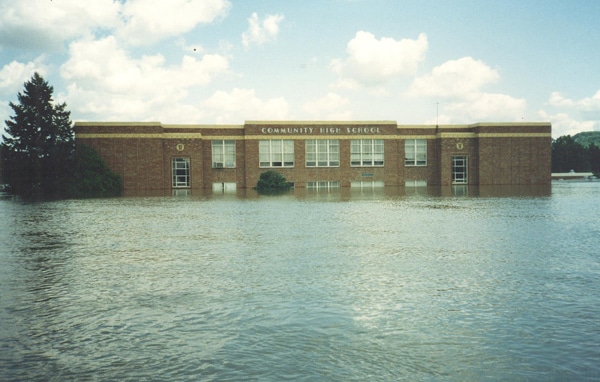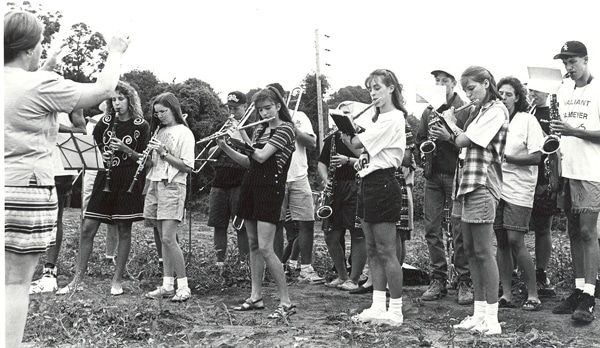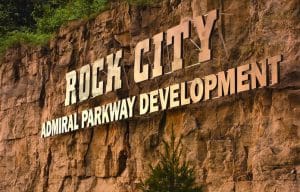Students of the flood remember ‘93

Pictured is the old Valmeyer High School submerged during the Flood of 1993. (submitted photo)
On Aug. 1, 1993, the Mississippi River crested at nearly 50 feet and, despite weeks of valiant fighting, burst through a levee south of Columbia.
The first victim of the merciless water was Virgil Gummersheimer’s farmstead, but Valmeyer would soon follow.
The flood ravaged the town, forcing the community to relocate to higher ground on top of the bluffs.
After years of hard work, on Sept. 28, 1996, the village dedicated its new home.
At the event, former mayor Dennis Knobloch, who had led the town throughout the flood and relocation process, gave a speech. In it, he discussed the impact of the flood of the children of the village.
“The kids here have lived a lifetime in the past three years,” he said. “They lived through a flood, the loss of their homes, the loss of their town and the rebuilding of their lives. They don’t realize it now, but in years to come they’re going to look back and be amazed at what they’ve been through.”
For the 25th anniversary of the flood destroying old Valmeyer, three former students and two former teachers reflected on the natural disaster and its impact on their lives.

The Valmeyer High School band performs the school song during the groundbreaking for the new school. (submitted photo)
Memories washed away
When the floodwaters poured into old Valmeyer, they did not discriminate. They destroyed houses, businesses, churches and the town’s school.
“We were kind of shielded from it as kids,” said Dennis’ son, Greg Knobloch, who was entering the seventh grade when the flood happened.
“I remember more of the aftermath – going down and just seeing everything and, as a kid, seeing how just a little bit of water caused all that destruction and the mess that it left,” he said.
But the children could not be completely shielded from the effects of the flood.
“It was scary and kind of weird seeing the parents cry or be upset,” said Angela Helms, who was 13 and about to enter eighth grade in the summer of 1993. “That wasn’t a side of them you usually got to see as a kid.”
The children eventually learned of the devastation the flood wreaked. For many of them, one of the most crushing realizations was when they discovered their school was ruined.
“That definitely brought tears,” remembered Helms, who now lives in Festus, Mo. “It was like your memories were all being washed away. I remembered all the times my friends had come to the playground and we would play until the streetlights came on and then it was time to go home. I realized I wouldn’t get to do that anymore.”
The destruction of the school also took its toll on the teachers who worked there.
“It was somewhere you never want to be,” said Valmeyer Mayor Howard Heavner, who taught agriculture at the school. “You didn’t know how many kids were gone or how many kids were coming back.”
“To me, it was school”
After the flood, one of the central issues facing the Valmeyer school district was how it would even continue.
Officials discussed building only an elementary school in what would become new Valmeyer. Under this plan, the high school students would travel to Waterloo for their education.
More pressingly, the district had to decide what to do with its students for the current school year. Some wanted them to go to other schools, but the Valmeyer school district, like the town itself, was determined to stay together.
By Sept. 8, 1993, only two weeks late, school began at a temporary school that had been set up at the Monroe County Fairgrounds for Valmeyer students.
“I was very glad that we kept school together,” said Donna Mueller, a Valmeyer first grade teacher in 1993. “I was worried the kids wouldn’t all get to stick together and get displaced. It was great and I owe that all to (former Valmeyer Superintendent) Harold Baum.”
The makeshift school consisted of three modular buildings, forcing teachers to maintain their standard of education with a limited space. According to former students, they did just that.
“Everything was crowded and cramped but, to me, it was school,” said Nick Unterseh, a classmate of Greg Knobloch. “My friends were there, my teachers were there and I had stuff to learn. To me, not much changed.”
Mueller and Heavner said the same was true of other students, who overcame the flood remarkably fast. But they did notice some differences.
“The kids used to play house during recess,” Mueller said. “After the flood, they would play ‘FEMA trailer.’ The little ones were really resilient. The kids probably did better than we did.”
Greg Knobloch said students were able to maintain such high spirits for a reason.
“The school was more than just the building – it was the people that you were with and were around,” he said.
Nevertheless, the students did face some hardships. One that all three former students mentioned was the lack of athletic facilities.
“It didn’t feel like you had home field or home court advantage,” Helms said. “And it didn’t feel like we did until we got our own school back.”
A new normal
Once the town rebuilt and relocated, the district got its school back on March 11, 1996 when the new building held its first day of classes.
The students were ready for a new, permanent facility.
“The new school was a lot of excitement, especially going from the trailers,” said Unterseh, who now lives in Columbia and teaches social studies at Valmeyer Junior High School. “Being a freshman, it was neat to be in the first class to be there all four years.”
The teachers shared that excitement.
“It was quite a relief,” Heavner said. “The other schools in the area were very accommodating while we had to use their facilities, but it was nice to have our own facilities again. It felt like we were out of the wilderness.”
“I felt like it was a step toward a new normal,” said Mueller, who worked in the district 34 years and eventually became a principal before retiring. “We were back in town with our friends and family. It was a new normal, but not back to normal.”
Looking back, the students said they were even more appreciative of the adults’ decision to keep the community and school together.
“I am extremely grateful for those on the village board and Dennis for deciding to have Valmeyer rebuilt instead of letting us drift into different communities,” Helms said. “I’m glad my siblings and the rest of my family had the chance to live in that tight-knit community like I did.”
“Your community is your life”
Even after 25 years, the flood has continued to impact the lives of those affected by it.
“Our life is pre-flood and post-flood,” Mueller said. “You talk about ‘that was before the flood’ or ‘this was after the flood.’ And we still do that after 25 years.”
While it may not have seemed that way at the time, the Flood of 1993 provided some positives and different lessons to all those involved.
“I think it prepared me to handle difficult situations and natural disasters,” said Helms, who is now a principal in Pevely, Mo. “It helped me in my job I have now because I have to be on my toes for safety concerns for everybody. It just made me a more well-rounded person.”
It also impacted a decision Mueller made later in life. She now works part-time for the Regional Office of Education assisting displaced children.
“I totally relate to those people who are out on their own because I was after the flood,” she said.
Greg Knobloch, who now teaches fifth grade in Valmeyer and lives in the new town, said the flood taught him the importance of community.
“It kind of cemented the idea that I wanted to be in a small town and settle somewhere like Valmeyer where you know your neighbors, your kids can play outside and the centerpiece of the small town is the school and the sense of community,” he said. “It just grew this idea inside me that your community is your life.”
You can also read a three-part, award-winning series written in 2013 by Andrea Degenhart-Saathoff commemorating the 20th anniversary of the Flood of 1993:
1993: beginning of the end for old Valmeyer
Dark days for Valmeyer in ’93
After the flood: Valmeyer moves to higher ground






